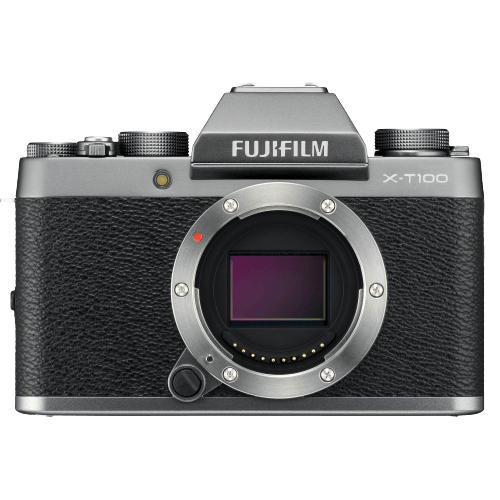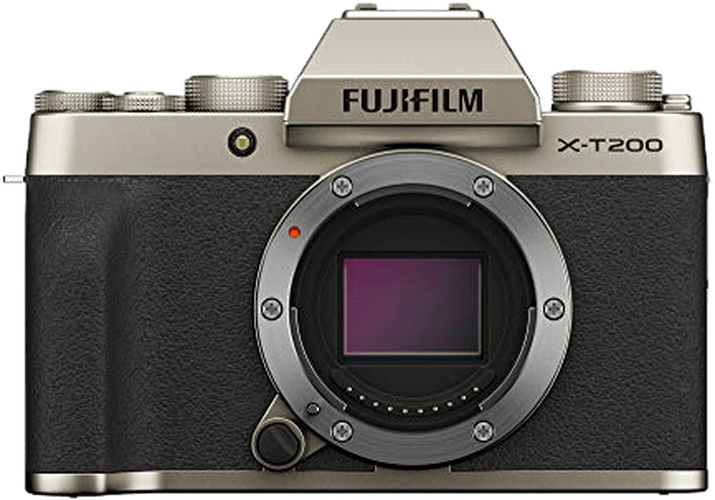Fujifilm X-T100 vs X-T200 Comparison
Fujifilm X-T100

Fujifilm X-T200

The Fujifilm X-T200 emerges as the winner with a score of 66/100, while the Fujifilm X-T100 trails behind at 62/100. Both cameras share common features, such as being mirrorless and having similar dimensions, with the X-T100 measuring 121 x 83 x 47mm and the X-T200 at 121 x 84 x 55mm.
The X-T200 has an edge over the X-T100 due to its more recent release in 2020, compared to the X-T100’s 2019 release. This results in a slightly higher launch price of $699 for the X-T200, while the X-T100 costs $600. Additionally, the X-T200 is lighter, weighing only 370g, as opposed to the X-T100’s 448g.
However, the X-T100 does have a smaller body and a more budget-friendly price. Ultimately, the Fujifilm X-T200’s higher score reflects its improved features and updated technology, making it a better option for those willing to invest a bit more. On the other hand, the Fujifilm X-T100 remains a viable choice for those seeking a more affordable and compact camera.
Fujifilm X-T100 vs X-T200 Overview and Optics
The Fujifilm X-T200 takes the lead in optics with a score of 67/100, compared to the Fujifilm X-T100’s score of 61/100. Both cameras share some common specifications: 24 megapixels, CMOS sensor type, unspecified processor, APS-C sensor size, Fujifilm X lens mount, and no DXOMARK score as the platform does not score Fujifilm cameras.
The X-T200 outperforms the X-T100 in two key areas. Firstly, the X-T200 has a faster shooting speed of 8 frames per second (fps), while the X-T100 lags behind at 6 fps. This advantage allows the X-T200 to capture fast-moving subjects and action scenes more efficiently. Secondly, the X-T200 features image stabilization, providing steadier shots and reducing the chances of blurred images due to camera shake. The X-T100 lacks this feature, making it less versatile in certain shooting situations.
On the other hand, the X-T100 does not have any notable advantages over the X-T200 in terms of optics. Both cameras have the same megapixel count, sensor type, and lens mount, making their image quality and lens compatibility virtually identical.
Taking these factors into account, the Fujifilm X-T200 emerges as the superior camera in terms of optics. Its faster shooting speed and image stabilization make it a more versatile and reliable choice for various photography situations. The Fujifilm X-T100, while sharing some of the same specifications, falls short due to its slower shooting speed and lack of image stabilization.
Fujifilm X-T100 vs X-T200 Video Performance
The Fujifilm X-T200 outperforms the X-T100 in video capabilities, scoring 91/100 compared to the X-T100’s 83/100. Both cameras share some common specifications, such as 4K max video resolution and 3840 x 2160 max video dimensions. Additionally, both cameras have built-in time-lapse functionality.
The X-T200’s higher score can be attributed to its superior max video frame rate of 120fps, double that of the X-T100’s 60fps. This allows for smoother slow-motion video capture and improved overall video quality. The X-T200’s faster frame rate provides more flexibility when recording fast-moving subjects or creating dramatic slow-motion effects.
On the other hand, the X-T100 does not offer any significant advantages over the X-T200 in terms of video capabilities. Its lower frame rate of 60fps may suffice for casual video users but may not meet the demands of more serious videographers or content creators.
Considering these factors, the Fujifilm X-T200 emerges as the clear winner in terms of video capabilities. With its higher video score and faster max video frame rate, it caters better to the needs of videographers and content creators. The X-T100, while still offering 4K resolution and time-lapse functionality, falls short in comparison due to its lower frame rate. Therefore, those prioritizing video performance should opt for the Fujifilm X-T200.
Fujifilm X-T100 vs X-T200 Features and Benefits
The Fujifilm X-T200 emerges as the winner with a feature score of 74/100, compared to the Fujifilm X-T100’s score of 70/100. Both cameras share several common specifications, including touchscreen capability, flip screen, absence of GPS, and the presence of WIFI and Bluetooth connectivity.
The X-T200 outperforms the X-T100 in screen size and resolution. The X-T200 has a 3.5-inch screen, which is larger than the X-T100’s 3-inch screen. Furthermore, the X-T200 offers a higher screen resolution of 2,780,000 dots, compared to the X-T100’s 1,040,000 dots. This means the X-T200 provides a clearer and more detailed display, enhancing the user experience.
On the other hand, the X-T100 does not offer any significant advantages over the X-T200 in terms of features. Both cameras have the same core specifications, and the X-T200 surpasses the X-T100 in screen size and resolution. Therefore, the X-T100 does not excel in any particular aspect when compared to the X-T200.
Considering the differences in feature scores and the specifications of both cameras, it is evident that the Fujifilm X-T200 is the superior choice. Its larger screen and higher resolution provide a better user experience, making it the more desirable camera. While the Fujifilm X-T100 is a competent camera, it does not offer any advantages over the X-T200 in terms of features.
Fujifilm X-T100 vs X-T200 Storage and Battery
The Fujifilm X-T100 has a higher storage and battery score of 37/100, compared to the Fujifilm X-T200’s 29/100. Both cameras have one memory card slot and accept SD, SDHC, and SDXC cards (UHS-I compatible). They also both offer USB charging and use the NP-W126S battery type.
The X-T100 outperforms the X-T200 in terms of battery life, providing 440 shots per charge, while the X-T200 only offers 270 shots. This longer battery life makes the X-T100 a better choice for extended shooting sessions or when charging options are limited.
The X-T200, however, does not have any advantages over the X-T100 in terms of storage and battery. Both cameras share the same storage options and USB charging capabilities.
Considering the storage and battery aspects, the Fujifilm X-T100 is the better option due to its longer battery life, while the Fujifilm X-T200 does not offer any advantages in this category.
Fujifilm X-T100 vs X-T200 – Our Verdict
Are you still undecided about which camera is right for you? Have a look at these popular comparisons that feature the Fujifilm X-T100 or the Fujifilm X-T200:

